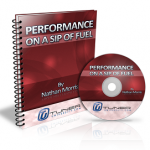Nitrous, or Nitrous Oxide is a power adder that provides incredible "Bang for the Buck" but for a number of reasons that we'll explore today, almost never gets used, and that's a shame because there's really no better way to get a reasonable boost in power for peanuts.
Nitrous has a bad reputation for blowing up engines and is often even called "cheating." Additionally, it gets a bad rap for not being "always available" and for needing refills to keep the power going.
All of these rumors have some basis in fact but as with almost anything, when used correctly, the benefits of nitrous are HUGE, especially for the target audience of this site: daily driven performance enthusiasts.
The biggest benefit of nitrous is that it provides enormous "bang for the buck." You can purchase a nitrous kit, brand new for around $500 with everything you really need to start using it, maybe as much as $700 if you get all the bells and whistles, and instantly strap on 15, 35, 55, 65, 75, 125 or even 150 horsepower. The kits are usually pretty straight forward to install and the nitrous re1fills are about $40-50 or so at the time of this writing.
In a naturally aspirated engine, gaining 35-55 horsepower can be tough with any amount of money, and typically it costs more than the "fully loaded" nitrous kit (plus several bottle refills) to get even 15-20 horsepower out of your car. In most cars, a 10-20% improvement with bolt-ons can be had, but even a very low shot of nitrous can be worth significantly more, especially in otherwise low performance cars.
If you buy a second hand kit from someone, you have an even more price competitive solution. For example, I once bought a second hand "Zex" brand kit for about $200 locally which was good for a 55-75hp gain depending on jet settings and tuning. That's enormous "bang for the buck"
So why don't more people use nitrous?
Well, one of the rumors out there is that nitrous destroys your engine. However, this is completely untrue. Nitrous oxide is no more damaging to your engine than any other modification by itself, but like a turbo kit or add-on supercharger, the potential for blowing your engine goes up significantly due to the enormous amount of additional stress being put on your engine and the chances of running lean or experiencing pre-ignition due to heat.
You see, your engine can burn as much air/fuel as you can jam into the cylinders. The limitations are fuel delivery, spark plug/combustion chamber design and the physical strength of the engine itself to withstand cylinder pressures that can become quite high with forced induction solutions like nitrous, turbos, and superchargers.
However, nitrous is no more dangerous than a turbo or supercharger. To understand why, I'll have to unpack what nitrous is a bit.
Nitrous is Nitrous Oxide, a gas which you may have been given if you've ever had surgery. It's "laughing gas." In the medicine field, it's used to relax patients before procedures and is actually abused by some people for its euphoric effects. In an engine, nitrous is an oxidizer and to some degree a chemical/physical compressor of the air charge.
Oxidizers, for the purposes of this article, are compounds which provide dense amounts of Oxygen molecules to a reaction (such as the combustion of gasoline and air). Essentially nitrous serves as compressed air that is far more oxygen dense than the air around us. It is itself, not flammable, but under intense pressure and heat provides enormous "fuel to the fire" in your engine. Any time you detonate (not burn) a fuel like gasoline with an oxidizer, the resulting explosion is impressively powerful (for example, the combination of diesel fuel + ammonium nitrate, a different oxidizer are popular for demolition work and unfortunately also improved explosives in terrorism).
As we know, the more oxygen we can pack into a cylinder with the appropriate amount of fuel, the more POWER we can produce. Nitrous also super cools the air going into the engine as it is sprayed into the intake tract, this further allows more air and fuel to be packed into the engine with each rotation. In effect, this super chilling of the air is similar to the effect of compressing air by mechanical means (such as with a turbocharger).
The danger with nitrous, is the same as a turbocharger or supercharger, if you pack way too much air/oxygen in with not enough fuel, temperatures can sore inside the cylinder and cause components to melt/warp. To avoid that problem, we simply make absolutely sure that the air/fuel mixture is relatively rich (lots of fuel to keep things cool) and we do everything we can to avoid pre-ignition by running conservative ignition timing of either stock values or slightly "retarded" values.
The reason that engines fail with nitrous are the same that engines fail with boost. There is nothing particularly dangerous about nitrous, other than that people don't often treat it with the respect that they do a turbo for example. Treat it with respect and keep your power gains reasonable and you shouldn't have any troubles with nitrous.
Next is the idea that nitrous is "cheating." I suppose it is if it's against the class rules in your racing class, but for a street car, it's absolutely not cheating. In a street car, or an occasional "for fun" dragster or something, I don't see any problems with it. If the end goal of a high performance street car is to give the driver some enjoyment for a minimum outlay of cash, then nitrous might be a great way to do that.
As for the "not always available" argument, that's very true. If your bottle is empty, you will have to refill it, that is true. However, if your gas tank is empty or you have no oil in your engine, it doesn't matter how much power you have normally, your car still isn't winning a race now is it? Same is true for nitrous, it's just an additional "fuel" that you need to run the car at its optimum performance level, no big deal.
The thing about nitrous that makes it unique compared to other forced induction solutions as well as all motor techniques, is that it produces torque (POWER) - instantly. Whereas a turbocharger produces variable amounts of additional torque based on how much boost it's producing, nitrous instantaneously adds torque with no lag. For this reason, even in high powered turbo cars you'll often see nitrous added to make up for turbo lag caused by the enormous turbocharger and get the car into boost faster.
It doesn't matter if you're at 2500rpm or 8000rpm, you'll still get gobs of torque with nitrous. Typically, this means that given the same peak power output, the nitrous car will beat the all-motor or turbo/supercharger car, all else being equal and traction dependent.
As for long term cost effectiveness, it depends on how much power you're looking to add. If you'd be happy with a 35-75 horsepower gain (which is usually somewhat conservative), then a 10lb bottle in a daily driver can last for MONTHS depending on your driving habits, jet settings, and if you have it always ON or if you only use it when you really just want a laugh. Refills aren't that expensive in the grand scheme of things and there are a lot of refills before you buy a comparable turbo kit even when you consider the kit cost.There A LOT more refills before you build a comparable "all motor" build.
Once you go over 75hp or so, I begin to see the cost effectiveness argument, but it depends on the expected use of the car and the cost of the comparable turbo/supercharger components to get there. With 75-150hp settings you can always install a second bottle to get more time before refills, the 25 pounds for the entire kit are highly offset by the 75-150 hp gain, are they not?
If a fully loaded (all the gizmos, bottle heater, rpm window switch, etc) "basic" kit costs around $800, let's say. Then let's say you can get an awesome deal on a complete turbo kit (that's actually complete and not just some eBay "some modification" required kit) for $2000. There is a $1200 spread there. There are 24 bottle refills between the two options if a refill costs $50. The odds are good that no matter how much you drive hard, you won't go through 24 bottle refills in the time you own your car.
Bottles of nitrous do go fast at the drag strip, typically you'll see a bottle last about 8-10 solid runs at a lower nitrous setting (around 55hp), or roughly about as many runs as you can get at a typical test-n-tune event anyway. The thing is, very few people actually go WOT for a full quarter mile on the street, so the length of time the nitrous will last is actually quite significant, especially if most of your "WOT runs" are on on-ramps and to pass people on the highway.
Nitrous can be used with nearly any build. It works great with other power adders (such as turbos and superchargers) and it is not incompatible with most "all motor" setups.
Nitrous kits are also nearly universal, in other words, if you buy a 4-6 cylinder kit, it can be used with nearly any 4-6 cylinder car you ever purchase. Of course, that's not true of nearly any other power adding solution, so you can keep your kit and upgrade your kit from car to car. In the long run, this makes it significantly less expensive than other options, even if you add in the cost of nitrous refills.
Safety and legality is one concern that needs addressing. Nitrous is not without risk. Compressed gas has to be treated with respect. A punctured compressed gas container can become a rocket, and excessive heat can cause a compressed gas container to literally explode. The amount of heat needed can only come from an external source, but it's important to understand this risk and do everything you can to mitigate it. If you are going to use nitrous, the bottles should be in the trunk. Check your local laws because in some states it is illegal to have nitrous in the vehicle, in others it's legal with certain rules (can't be open/hooked up), and in others there are no regulations on the books at all. I am a safety fanatic, so with nitrous I believe it should always be very firmly mounted in a place unlikely to be damaged during an accident (close to the trunk firewall, towards the center of the car, for example). There should always be a plate of steel that separates the bottle from the passenger compartment. When wiring bottle heaters and other electronics related to your nitrous, always follow directions.
One important note is to always ensure that all nitrous components are on switched 12v sources so that they are only turned on when the engine is running. This is particularly true of bottle heaters. Bottle heaters have safety mechanisms implemented into them, however, always have additional fail safes. Ideally, a switched 12v source powers the electronics but additionally requires the user to activate them for them to turn on.
I think it's always a good idea to have a fire extinguisher in your vehicle anyway, it's particularly true when running power adders of any kind. If a fire should ever occur, only attempt to put it out if it's small and the source is known. Otherwise, get away from the car immediately. Cars can be replaced, you cannot.
The only reason to perhaps consider only one bottle instead of two, is safety. Less oxidizer in the car and fewer bottles do reduce the odds of an accident occurring.
Finally, nitrous has essentially no effect on fuel economy. Sure it uses more fuel when you're using it, but only when you're using it. Turbos are also great about producing great power without negatively effecting daily driving fuel economy. However, nitrous is ONLY activated at wide open throttle, so it only activates when you're asking the engine for all available power. Turbos however will use more fuel anytime you tip the throttle far enough to get into boost. That's a fine trade off for most people, but it is a plus in the nitrous corner.
So, while some common sense safety measures are necessary with nitrous (or really any significant power adders), it's actually a pretty cost effective way to add some fun to your daily driver.
If all your looking for is a nice "bump" in your car's performance, then honestly it's hard to beat it.
Extremely Limited Time Offer - 3 Days Only
Get a MASTERS DEGREE in Performance Tuning from the BEST in the Field for ONE low package price
For 3 days only, get ALL of our PREMIUM (not available anywhere else) Tuner University Courses featuring some of the greatest minds in motorsports:
- Top 10 Performance Myths Class (MP3 and Edited Transcript) - $29.95 value
- Performance on a Sip of Fuel Class (MP3 and class manual) - $69.95 value
- Header Design Secrets with John Grudynski (MP3 and transcript) - $69.95 value
- Dirty Secrets of Oil with Ryan Stark (MP3 and transcript) - $69.95 value
- Engine Tuning Secrets with Ben Strader of EFI University (MP3 and Transcript) - $69.95 value
Get all of the above courses (many of which not currently available anywhere else) for one single price of just $309.75 $69.95. A HUGE package savings.
You can also buy any of these individually through our resource center, but I don't know why you would as this is basically the whole store for the price of just 1 course. You'll get the MP3 recordings of each class as well as a transcript or companion manual with each course and you'll be able to download them all INSTANTLY.






